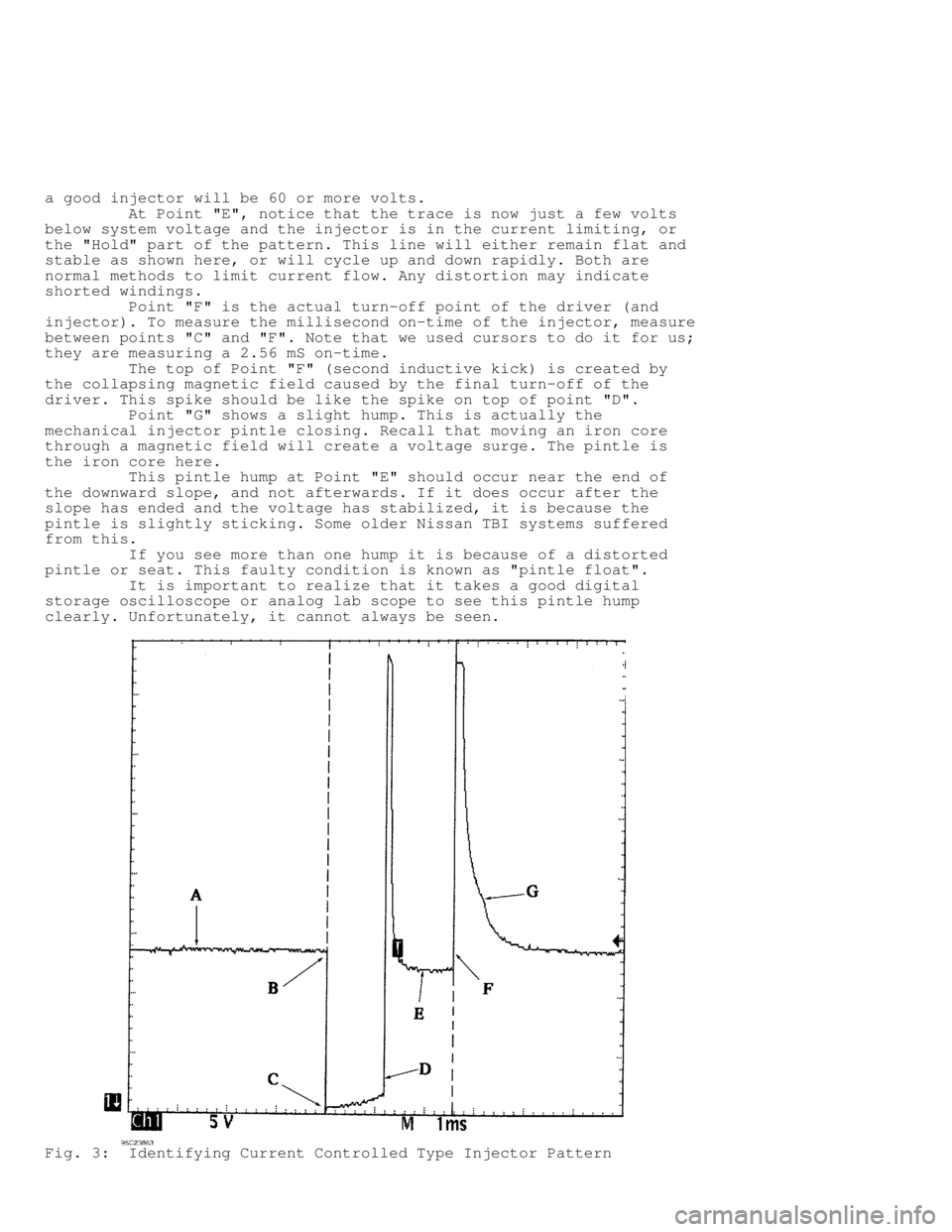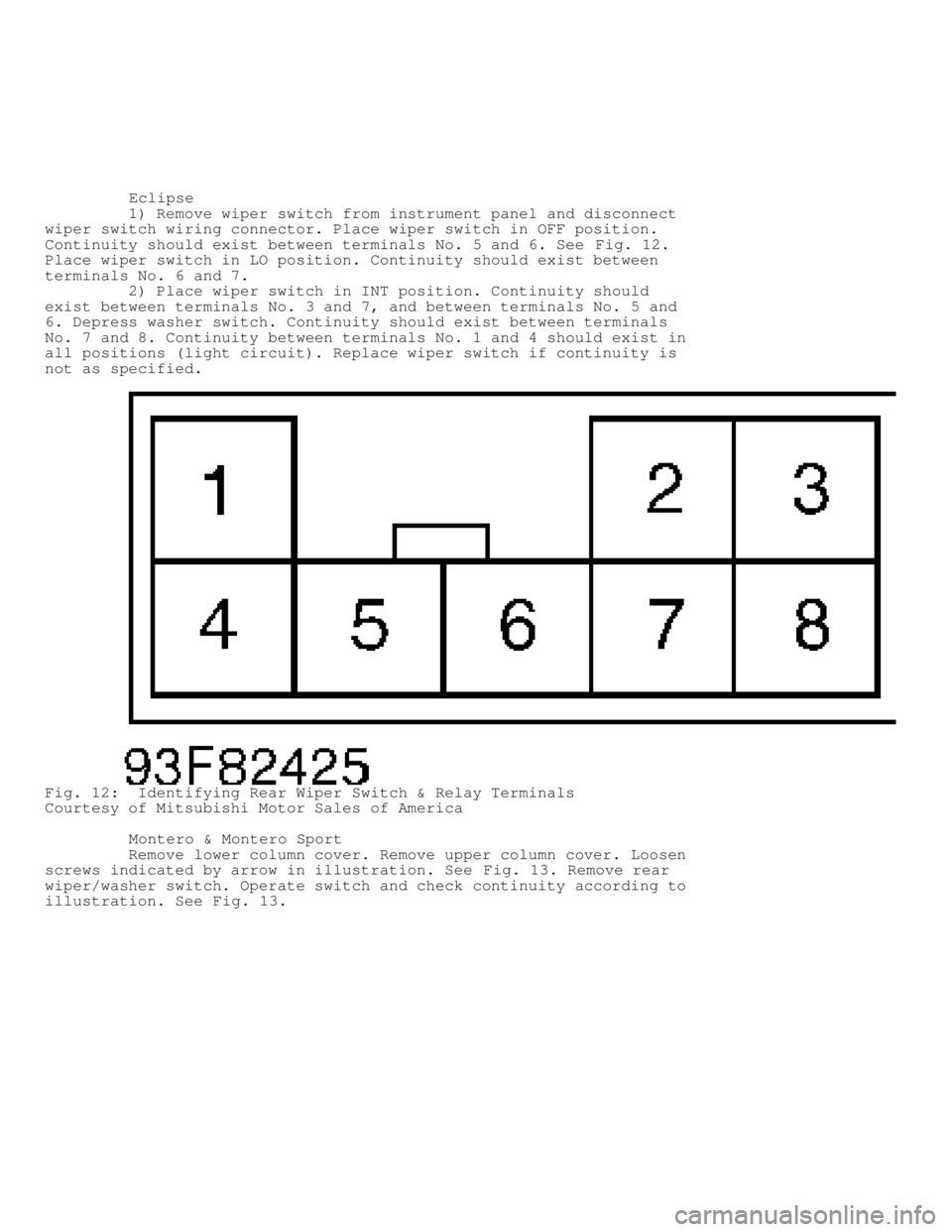Page 1441 of 1501

a good injector will be 60 or more volts.
At Point "E", notice that the trace is now just a few volts
below system voltage and the injector is in the current limiting, or
the "Hold" part of the pattern. This line will either remain flat and
stable as shown here, or will cycle up and down rapidly. Both are
normal methods to limit current flow. Any distortion may indicate
shorted windings.
Point "F" is the actual turn-off point of the driver (and
injector). To measure the millisecond on-time of the injector, measure
between points "C" and "F". Note that we used cursors to do it for us;
they are measuring a 2.56 mS on-time.
The top of Point "F" (second inductive kick) is created by
the collapsing magnetic field caused by the final turn-off of the
driver. This spike should be like the spike on top of point "D".
Point "G" shows a slight hump. This is actually the
mechanical injector pintle closing. Recall that moving an iron core
through a magnetic field will create a voltage surge. The pintle is
the iron core here.
This pintle hump at Point "E" should occur near the end of
the downward slope, and not afterwards. If it does occur after the
slope has ended and the voltage has stabilized, it is because the
pintle is slightly sticking. Some older Nissan TBI systems suffered
from this.
If you see more than one hump it is because of a distorted
pintle or seat. This faulty condition is known as "pintle float".
It is important to realize that it takes a good digital
storage oscilloscope or analog lab scope to see this pintle hump
clearly. Unfortunately, it cannot always be seen.
Fig. 3: Identifying Current Controlled Type Injector Pattern
Page 1478 of 1501

REAR WIPER ARM ADJUSTMENT
NOTE: Diamante, Galant and Mirage are not equipped with rear
wipers.
Ensure wiper motor is in park position. Position wiper arm
and blade assembly so tip of blade is specified distance from edge of
window. See REAR WIPER ADJUSTMENT SPECIFICATIONS table.
REAR WIPER ADJUSTMENT SPECIFICATIONS TABLE
������������������\
������������������\
������������������\
������������������\
������������������\
������������������\
�����������
Model In. (mm)
Eclipse .............................. 4.98-5.38 (125-135)
Montero & Montero Sport ................ 2.56-2.95 (65-75)
3000GT ............................................... ( 1)
( 1) - Position blade tip along ceramic edge of window.
������������������\
������������������\
������������������\
������������������\
������������������\
������������������\
�����������
COMPONENT TESTS
* PLEASE READ THIS FIRST *
NOTE: For headlight washer switch testing on Montero,
see STEERING COLUMN SWITCHES article.
WASHER MOTOR TEST (FRONT & REAR)
1) Ensure washer reservoir fluid is at proper level. Turn
ignition switch to ON position. Press washer button on wiper/washer
switch. If fluid does not spray on windshield, turn ignition off.
Check for plugged washer hoses from washer reservoir to windshield
nozzle. Repair as necessary.
2) If washer hoses are not plugged, disconnect washer motor
electrical connector. Check for poor connection or connector damage.
Repair as necessary. If connector is okay, connect battery power to
washer motor terminals. Washer motor should operate. Replace motor as
necessary.
FRONT WIPER MOTOR TEST
Checking Wiper Motor Operation
Disconnect wiring connector from wiper motor. Connect battery
voltage to wiper motor connector as shown, and ensure wiper motor
operates at low and high speeds. See Fig. 1 or 2. Replace motor as
necessary.
Checking Automatic Stop
1) Operate wiper motor at low speed. See Fig. 1 or 2.
Disconnect battery voltage during operation to stop motor.
2) Using a jumper wire, connect terminals as shown. See
Fig. 1 or 2. Connect 12 volts to indicated terminal, and ground wiper
motor bracket. Ensure wiper arm is correctly parked. Replace motor as
necessary.
Page 1487 of 1501

Eclipse
1) Remove wiper switch from instrument panel and disconnect
wiper switch wiring connector. Place wiper switch in OFF position.
Continuity should exist between terminals No. 5 and 6. See Fig. 12.
Place wiper switch in LO position. Continuity should exist between
terminals No. 6 and 7.
2) Place wiper switch in INT position. Continuity should
exist between terminals No. 3 and 7, and between terminals No. 5 and
6. Depress washer switch. Continuity should exist between terminals
No. 7 and 8. Continuity between terminals No. 1 and 4 should exist in
all positions (light circuit). Replace wiper switch if continuity is
not as specified.
Fig. 12: Identifying Rear Wiper Switch & Relay Terminals
Courtesy of Mitsubishi Motor Sales of America
Montero & Montero Sport
Remove lower column cover. Remove upper column cover. Loosen
screws indicated by arrow in illustration. See Fig. 13. Remove rear
wiper/washer switch. Operate switch and check continuity according to
illustration. See Fig. 13.
Page 1489 of 1501

1) Remove wiper switch from instrument panel and disconnect
wiper switch. Place wiper switch in OFF position. Continuity should
exist between terminals No. 4 and 5. See Fig. 12. Place wiper switch
in ON position. Continuity should exist between terminals No. 5 and 6.
2) Place wiper switch in INT position. Continuity should
exist between terminals No. 4 and 5, and between terminals No. 7 and
8. Depress washer switch. Continuity should exist between terminals
No. 2 and 6. Continuity between terminals No. 1 and 3 should exist in
all positions (light circuit).
REMOVAL & INSTALLATION
FRONT WIPER MOTOR
Removal & Installation
Remove wiper motor bolts. Pull motor out slightly. Disconnect
wiper linkage from motor assembly and remove motor. To install,
reverse removal procedure.
FRONT WIPER SWITCH
NOTE: Front wiper switch is part of combination switch on steering
column. See STEERING COLUMN SWITCHES article.
REAR WIPER MOTOR
Removal & Installation
Remove wiper blade and arm assembly. Remove tailgate trim, 2
bolts and wiper motor. To install, reverse removal procedure. Ensure
grommet is in good condition.
REAR WIPER SWITCH
Removal & Installation
Pry rear wiper switch from instrument panel and disconnect
wiper switch wiring connector. To install switch, reverse removal
procedure.
WIRING DIAGRAMS
Page 1497 of 1501
Fig. 21: Wiper/Washer System Wiring Diagram (Montero - Headlight
Washers)